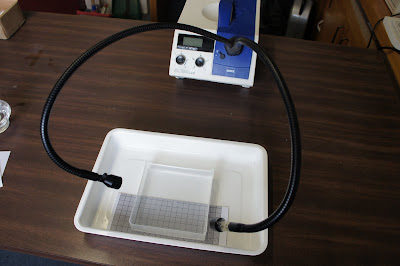But generating good vouchers in molecular studies is hard. Formalin, the fixative chemical of choice for ichthyologists, degrades DNA and makes extraction/PCR difficult (but see Zhang, 2010). Instead, ethanol can be used as a fixative, but ethanol fixed specimens are often brittle, faded, and of poorer long-term quality.
It's often best to take a tissue sample from your specimen, store this in ethanol, and formalin fix the rest of the fish as a voucher. This is fine, but you'll want to know which tissue sample comes from which specimen, and for small fishes it's not possible to permanently attach the label to the specimen without causing damage. Of course, you could put them all in individual jars, but you could soon run out of jars or space. Transporting them is a big problem too, and this is where you really need to save space.
So, after trying out some quite unsatisfactory methods, and ruining many good specimens, I have developed a nice method of generating quality molecular vouchers:
Step 1. Fill vials for tissue samples with high-grade 100% ethanol. Label the tubes internally with pencil on archive quality "goatskin" paper, and externally with marker pen. The vouchers can be kept separate using small polythene zip-seal bags. They need to be perforated first, however, with a paper hole punch (do several at a time). They should also have their bottom corners cut off to allow the bags to drain. Place another label in the bag.
Step 2. Get everything ready in advance. Here I have:
- Latex gloves
- 10% formalin (clearly labelled)
- MS-222 (fish anaesthetic)
- Spirit burner to decontaminate tools
- Variety of forceps and scalpel
- Pencil
- Squares of cardboard to use as a clean surface for tissue preparation.
- Vials for tissue samples
- Bags for voucher
Step 3. Assemble your light source and photo rig. Here I use an adjustable microscopy light (halogen desk lamps can be substituted) and a shallow white tray. I used a piece of folded graph paper as a scale for these photos. Now, mix up your MS-222 (overdosed) and water into a shallow clear tray (the lid of a tube rack), and the fish can now be added (wait for 10 mins to ensure death). Make sure the fish is only just covered.
Step 4. Adjust the light angle and photograph the left-hand side of the fish, always adding the label. Remember to set your camera's white balance correctly (usually using the custom mode). The picture can then be cropped and the file name changed.
Step 5. Take the fish out of the solution and place on the card sheet. Use the scalpel to carefully excise a tissue sample from the right-hand side of the fish. Pectoral fin clips can also be taken to cause less damage, but on small fishes this won't yield much tissue, and using mitochondrion rich muscle may reduce the likelihood of numts (Song et al., 2008).
Note: don't cut from the caudal peduncle area if characters such as caudal peduncle scale counts may be important for identifying your fish.
Step 6. Next, place the fish into the plastic bag with the forceps, and place into the formalin. The position of the fish and fins can be manipulated through the holes in the bag with the forceps. This ensures the fish is not bent and the fins are not folded down.
Step 7. Throw away the card sheet and replace with new. Clean the implements with a wet tissue and then sterilise with the spirit burner. Repeat process for rest of specimens.
Step 8. Leave vouchers in formalin for approximately three days (longer for larger fishes). After three days, remove from formalin and wash thoroughly with water. Leave in water for 24 hours to dilute remaining formalin. Place into weak 35% alcohol (ethanol or clear methylated spirit) solution for three days before final storage in 70% alcohol. The voucher will have lost a lot of its colour by now, but can be photographed again to document the preserved colour pattern.
Of course, these bags have not been tested for long-term (i.e. indefinite) storage, and are only recommended as a temporary (<5yr) storage or transport solution.
In addition, although I haven't yet tested it, this method could hopefully be adapted for use in the field.









No comments:
Post a Comment